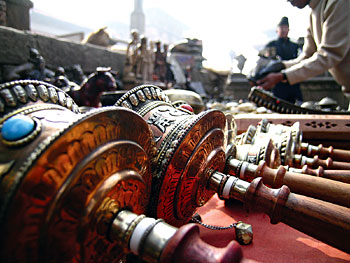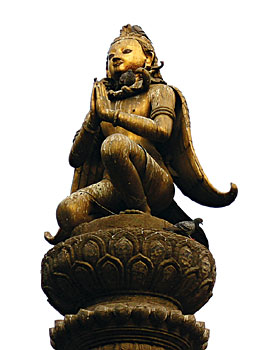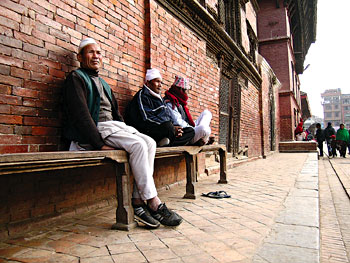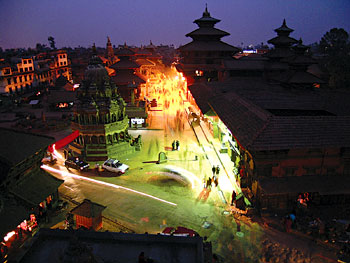As the fog slowly lifts in Patan Durbar Square, Mangalbajar wakes to piped temple bells and a serene chorus of bhajans.
Approaching from the west side of the square, one can hardly ignore the breathtaking beauty of the 15th-century Malla palace. Following the chants takes you to Krishna Mandir, where barefooted women with baskets full of flowers, butter lamps and other offerings scurry along to line up in front of the temple.
The pigeons fight to feed on grains scattered by a woman who appears unconcerned as they flock and flap around her. She barely looks up as the birds suddenly take flight together.
For a long time, the pigeon lady and I are the only ones sitting in front of the temple. It is still dark and all I can see are the silhouettes of Krishna Mandir and the butter lamplights. The flower lady brings baskets of yellow and marigold garlands and sits near the main path leading to the temple.
One by one the vegetable vendors pass by with spinach, cauliflower and carrot on their kharpans. They are not allowed in the square area, so they set up their temporary shops in front of the waterspout, where a couple of stalls have already started firing up kerosene stoves for tea.
Astha Laxmi Shakya, 50, has been selling flowers for 16 years in front of Krishna Mandir. "So much has changed," says Shakya sipping her tea. "I see new faces everyday, most of my old customers are dead and gone and the square is not what it used to be."
She sighs and explains that the young people who should be taking care of the square are leaving town in search of better opportunities.
It is almost 8AM, the bajar a little further down from the temple is bustling with people taking sips from steaming cups of tea, smoking their first morning cigarette and discussing politics. The cleaning ladies arrive, sweeping along the pathway. They work systematically-one cleans the left side while the other takes the right and they push the rubbish into little piles along the pathways.
The ladies create a cloud of dust as they move. From the dust emerge young teenagers carrying traditional instruments. They pass the street between the temple and the museum entrance beating their drums and bells-chyam chyam chyam chyam. The flower lady, vegetable sellers, tea stalls and the pigeon lady all pack up and leave for the day just as a truck arrives to collect the garbage.
Right behind the truck, children dressed in neat school uniforms follow. Their ties are nicely knotted and their trousers have the necessary creases. At the south side of the square a young man has set up a temporary newspaper shop attracting a curious crowd. Some people stop and buy a paper, stuff it in their bags and move on. Others try to take a quick peek at the headlines and then give up when they realize they will never push past the crowd.
Finally, the fog lifts completely and the shops along the busy roadside open. A music store blares Nepali pop. In the middle of the square, blue and red chairs are set up for a function to mark the anniversary of the 1934 earthquake. This is the ideal location for the event as part of the palace was reduced to ruins after the disaster and was later rebuilt.
People are dashing off to get to work; they push one another to try and climb aboard safa tempos.
It warms up and the tourists come and go with their guides. They stop at the rooftop cafes for a quick bite or a cup of coffee, they shoo away the little boys who follow them hawking more souvenirs. Elderly men sit on the benches outside the museum, soaking up the sun eating peanuts and oranges and watching as the day goes by.
The red and blue chairs are packed up as the day's function ends. By late afternoon, the schoolchildren who hastened to get to school in the morning wearing their neat uniforms are returning. With tired faces, dishevelled hair and loose ties, they hang out in the square, sipping tea from plastic cups.
The tea stall and vegetable sellers are also back. The tourists slowly disperse as the sun goes down. Women ride by on their scooters, taxis wait with their lights on and evening shoppers line up in front of the vegetable markets.
Suddenly it's dark everywhere as load shedding begins. But it's too early for the square to sleep so vegetable vendors, restaurants and bead and bangle sellers light tukis and stay open for business. Passers-by hurry home to their families and youngsters part ways.
The only place with electricity is the path between the Patan Museum and Krishna Mandir, which looks like a glowing caterpillar from atop a terrace. Looking down, the harmony of the different architectural styles strikes me: the museum's pagoda style next to the mandir's Shikhara look.
It is time to leave. From the west side of the square all I can see are the silhouettes of Krishna Mandir and the palace. It is dark and quiet but I can still hear the temple bells. For the last time I look at a place that has stood the test of time and I see it breathing as if waiting for a new day, new and new stories.
PHOTO GALLERY
ALL PICS: PRATEEK RAJBHANDARI


DAY DAWNS: The morning vendor displays the day's items.


Selling flowers to devotees.

Durbar Square is still quite empty early in the morning.

Locals rest outside Patan Museum after a hard day's work.

Durbar Square lights up as the day's activities come to an end.


